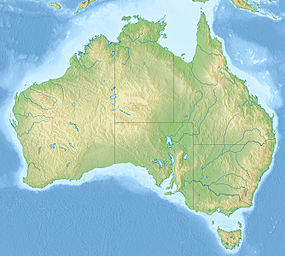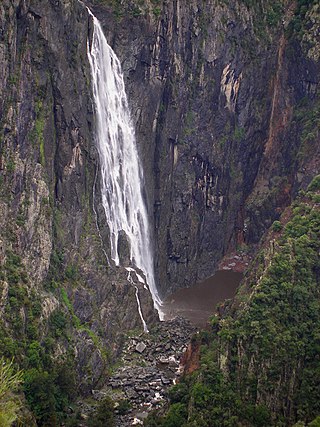
The Wollomombi Falls is a plunge waterfall on the Wollomombi River in the New England region of New South Wales, Australia.

The Fitzroy River, also known as Martuwarra, is located in the West Kimberley region of Western Australia. It has 20 tributaries and its catchment occupies an area of 93,829 square kilometres (36,228 sq mi), within the Canning Basin and the Timor Sea drainage division.

The Wunaamin Miliwundi Ranges are a range of hills in the western Kimberley region of Western Australia.
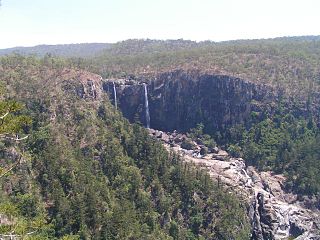
The Herbert River is a river in Far North Queensland, Australia. The southernmost of Queensland's wet tropics river systems, it was named in 1864 by George Elphinstone Dalrymple explorer, after Robert George Wyndham Herbert, the first Premier of Queensland.
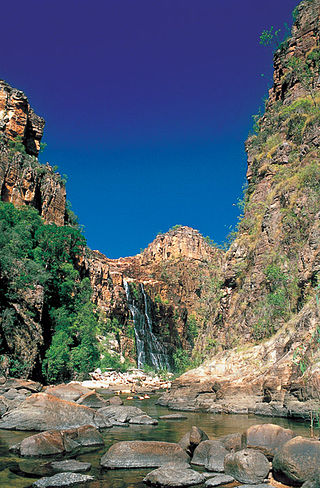
The Twin Falls is a cascade waterfall on the South Alligator River that descends over the Arnhem Land escarpment within the UNESCO World Heritage–listed Kakadu National Park in the Northern Territory of Australia. In 1980, The Twin Falls area was listed on the now-defunct Register of the National Estate.

The Wangi Falls is a segmented waterfall on the Wangi Creek located within the Litchfield National Park in the Northern Territory of Australia.
The Tjaynera Falls is a waterfall on the Sandy Creek that is located within the Litchfield National Park in the Northern Territory of Australia.

The Tolmer Falls is a plunge waterfall on the Tolmer Creek that is located in the Litchfield National Park in the Northern Territory of Australia.

The Blencoe Falls is a segmented waterfall on the Blencoe Creek, located in Kirrama, Tablelands Region, in Far North Queensland, Australia.

The Dip Falls, a cascade waterfall over cubic-basalt formed rocks on the Dip River, is located in Mawbanna in the North West region of Tasmania, Australia.

The Hopetoun Falls is a waterfall across the Aire River that is located in the Otways region of Victoria, Australia.

The Edith Falls is a series of cascading waterfalls and pools on the Edith River in the Nitmiluk National Park, located approximately 60 kilometres (37 mi) north of Katherine, in the Northern Territory of Australia.

The Waychinicup River is located in the Great Southern region of Western Australia. The headwaters of the river are located near the town of Manypeaks along the South Coast Highway, with an elevation of approximately 100 metres (328 ft) above sea level and flows in a generally southerly direction through the Mount Manypeaks Range then through the Waychinicup National Park until it discharges into the Southern Ocean.

The Tully Falls, a horsetail chute waterfall on the Tully River, is located in the UNESCO World Heritage–listed Wet Tropics in the Far North region of Queensland, Australia. It formed the eastern boundary of the Dyirbal.

Drysdale River is a river in the Kimberley region of Western Australia.

The Hunter River is a river in the Kimberley region of Western Australia.

Goobarragandra River, a perennial stream that is part of the Murrumbidgee catchment within the Murray–Darling basin, is located in the Snowy Mountains region of New South Wales, Australia. In the past, it was also known as Tumut Little River.

The Aire River is a perennial river of the Corangamite catchment, located in the Otways region of the Australian state of Victoria.

Montgomery Reef is a reef off the Kimberley coast of Western Australia. It is situated at the south western end of Camden Sound and surrounds Yawajaba (Montgomery) Island. With its total area of 400 square kilometres (154 sq mi), it is the world's largest inshore reef. The nearest populated place is Bardi, which is approximately 130 kilometres (81 mi) to the south west.
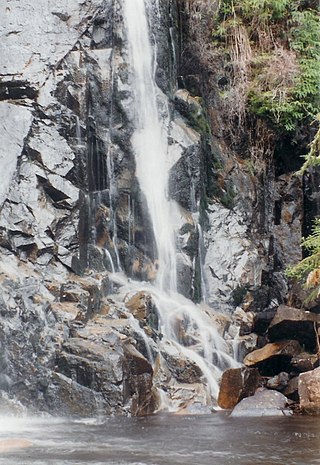
The Steavenson River, sometimes incorrectly referred to as Steavensons River, a minor inland perennial river of the Goulburn Broken catchment, part of the Murray-Darling basin, is located in the lower South Eastern Highlands bioregion and Northern Country/North Central regions of the Australian state of Victoria. The headwaters of the Steavenson River rise on the north–western slopes of the Yarra Ranges, below Mount Edgar and descend to flow into the Acheron River near Buxton.

